YAMAHA FJR1300AS 2013 Service Manual
Manufacturer: YAMAHA, Model Year: 2013, Model line: FJR1300AS, Model: YAMAHA FJR1300AS 2013Pages: 122, PDF Size: 3.34 MB
Page 41 of 122
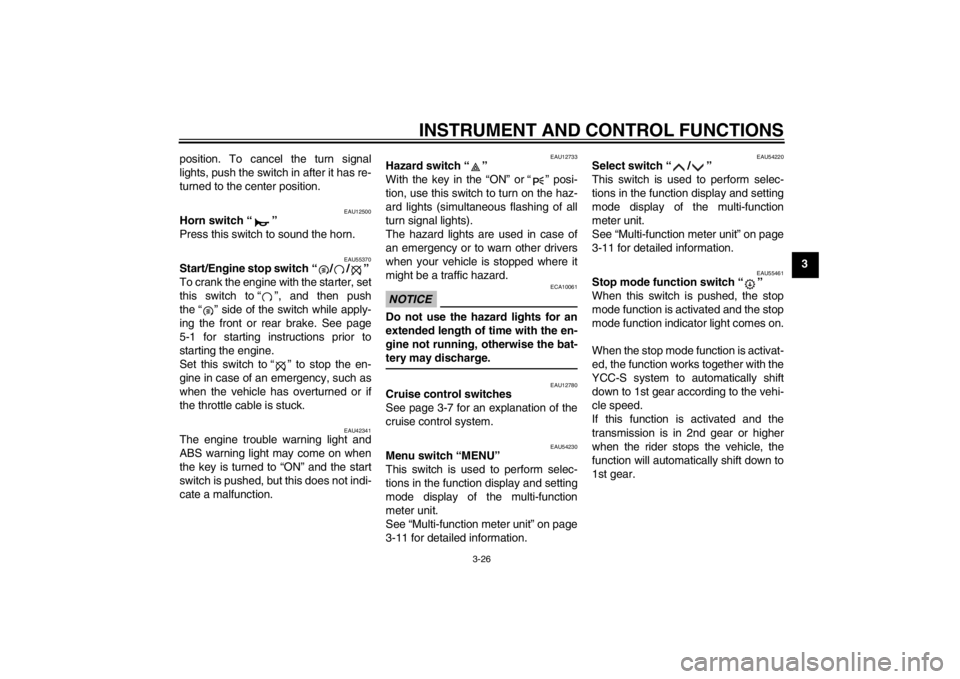
INSTRUMENT AND CONTROL FUNCTIONS
3-26
3
position. To cancel the turn signal
lights, push the switch in after it has re-
turned to the center position.
EAU12500
Horn switch “ ”
Press this switch to sound the horn.
EAU55370
Start/Engine stop switch “ / / ”
To crank the engine with the starter, set
this switch to “ ”, and then push
the “ ” side of the switch while apply-
ing the front or rear brake. See page
5-1 for starting instructions prior to
starting the engine.
Set this switch to “ ” to stop the en-
gine in case of an emergency, such as
when the vehicle has overturned or if
the throttle cable is stuck.
EAU42341
The engine trouble warning light and
ABS warning light may come on when
the key is turned to “ON” and the start
switch is pushed, but this does not indi-
cate a malfunction.
EAU12733
Hazard switch “ ”
With the key in the “ON” or “ ” posi-
tion, use this switch to turn on the haz-
ard lights (simultaneous flashing of all
turn signal lights).
The hazard lights are used in case of
an emergency or to warn other drivers
when your vehicle is stopped where it
might be a traffic hazard.NOTICE
ECA10061
Do not use the hazard lights for an
extended length of time with the en-
gine not running, otherwise the bat-
tery may discharge.
EAU12780
Cruise control switches
See page 3-7 for an explanation of the
cruise control system.
EAU54230
Menu switch “MENU”
This switch is used to perform selec-
tions in the function display and setting
mode display of the multi-function
meter unit.
See “Multi-function meter unit” on page
3-11 for detailed information.
EAU54220
Select switch “ / ”
This switch is used to perform selec-
tions in the function display and setting
mode display of the multi-function
meter unit.
See “Multi-function meter unit” on page
3-11 for detailed information.
EAU55461
Stop mode function switch “ ”
When this switch is pushed, the stop
mode function is activated and the stop
mode function indicator light comes on.
When the stop mode function is activat-
ed, the function works together with the
YCC-S system to automatically shift
down to 1st gear according to the vehi-
cle speed.
If this function is activated and the
transmission is in 2nd gear or higher
when the rider stops the vehicle, the
function will automatically shift down to
1st gear.
U1MDE0E0.book Page 26 Friday, February 15, 2013 1:26 PM
Page 42 of 122
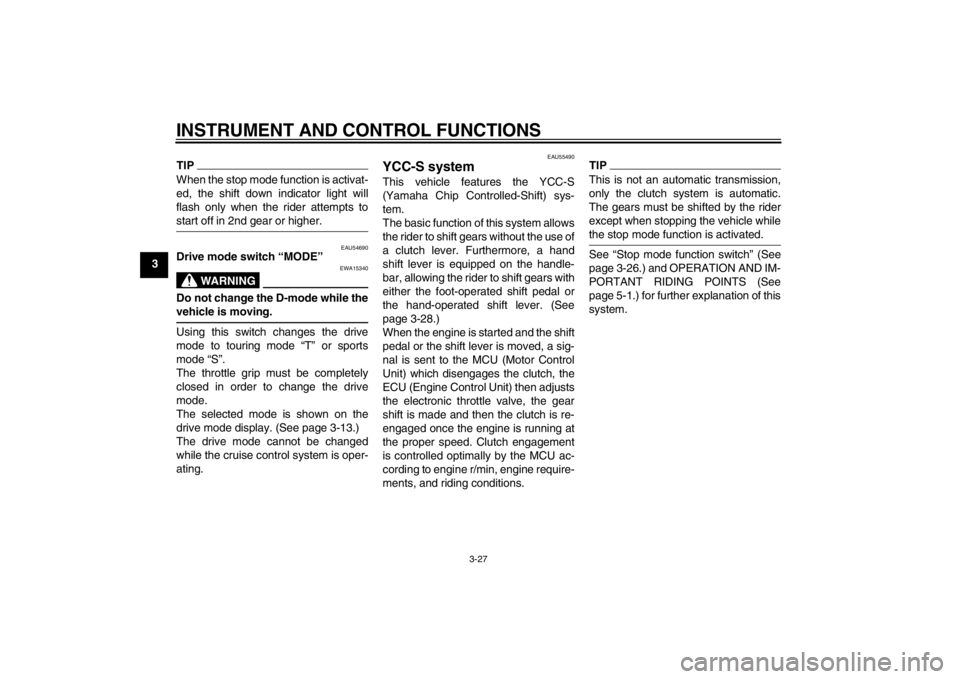
INSTRUMENT AND CONTROL FUNCTIONS
3-27
3
TIPWhen the stop mode function is activat-
ed, the shift down indicator light will
flash only when the rider attempts to
start off in 2nd gear or higher.
EAU54690
Drive mode switch “MODE”
WARNING
EWA15340
Do not change the D-mode while the
vehicle is moving.Using this switch changes the drive
mode to touring mode “T” or sports
mode “S”.
The throttle grip must be completely
closed in order to change the drive
mode.
The selected mode is shown on the
drive mode display. (See page 3-13.)
The drive mode cannot be changed
while the cruise control system is oper-
ating.
EAU55490
YCC-S system This vehicle features the YCC-S
(Yamaha Chip Controlled-Shift) sys-
tem.
The basic function of this system allows
the rider to shift gears without the use of
a clutch lever. Furthermore, a hand
shift lever is equipped on the handle-
bar, allowing the rider to shift gears with
either the foot-operated shift pedal or
the hand-operated shift lever. (See
page 3-28.)
When the engine is started and the shift
pedal or the shift lever is moved, a sig-
nal is sent to the MCU (Motor Control
Unit) which disengages the clutch, the
ECU (Engine Control Unit) then adjusts
the electronic throttle valve, the gear
shift is made and then the clutch is re-
engaged once the engine is running at
the proper speed. Clutch engagement
is controlled optimally by the MCU ac-
cording to engine r/min, engine require-
ments, and riding conditions.
TIPThis is not an automatic transmission,
only the clutch system is automatic.
The gears must be shifted by the rider
except when stopping the vehicle while
the stop mode function is activated.See “Stop mode function switch” (See
page 3-26.) and OPERATION AND IM-
PORTANT RIDING POINTS (See
page 5-1.) for further explanation of this
system.
U1MDE0E0.book Page 27 Friday, February 15, 2013 1:26 PM
Page 43 of 122
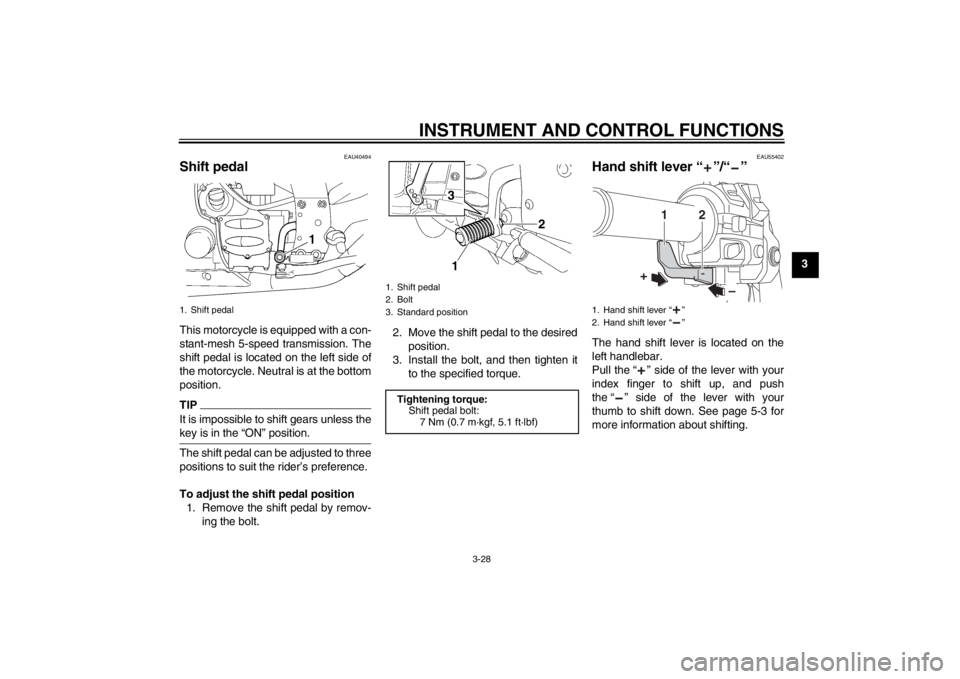
INSTRUMENT AND CONTROL FUNCTIONS
3-28
3
EAU40494
Shift pedal This motorcycle is equipped with a con-
stant-mesh 5-speed transmission. The
shift pedal is located on the left side of
the motorcycle. Neutral is at the bottom
position.TIPIt is impossible to shift gears unless the
key is in the “ON” position.The shift pedal can be adjusted to three
positions to suit the rider’s preference.
To adjust the shift pedal position1. Remove the shift pedal by remov- ing the bolt. 2. Move the shift pedal to the desired
position.
3. Install the bolt, and then tighten it to the specified torque.
EAU55402
Hand shift lever “ ”/“ ” The hand shift lever is located on the
left handlebar.
Pull the “ ” side of the lever with your
index finger to shift up, and push
the “ ” side of the lever with your
thumb to shift down. See page 5-3 for
more information about shifting.
1. Shift pedal
1. Shift pedal
2. Bolt
3. Standard position
Tightening torque:Shift pedal bolt:
7 Nm (0.7 m·kgf, 5.1 ft·lbf)
31
2
1. Hand shift lever “ ”
2. Hand shift lever “ ”
1
2
–
+
U1MDE0E0.book Page 28 Friday, February 15, 2013 1:26 PM
Page 44 of 122
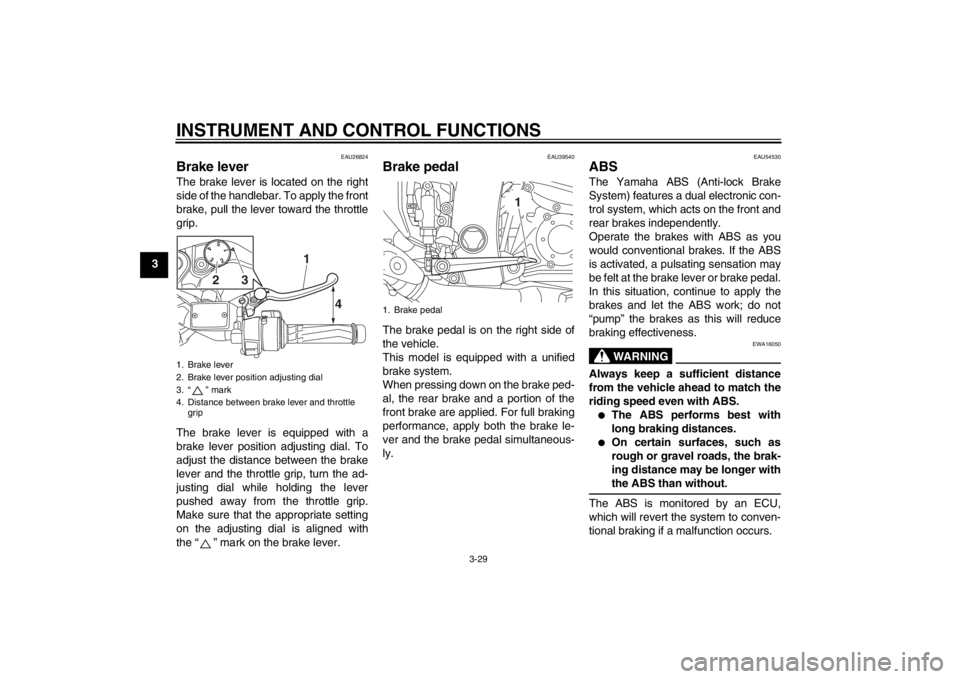
INSTRUMENT AND CONTROL FUNCTIONS
3-29
3
EAU26824
Brake lever The brake lever is located on the right
side of the handlebar. To apply the front
brake, pull the lever toward the throttle
grip.
The brake lever is equipped with a
brake lever position adjusting dial. To
adjust the distance between the brake
lever and the throttle grip, turn the ad-
justing dial while holding the lever
pushed away from the throttle grip.
Make sure that the appropriate setting
on the adjusting dial is aligned with
the “ ” mark on the brake lever.
EAU39540
Brake pedal The brake pedal is on the right side of
the vehicle.
This model is equipped with a unified
brake system.
When pressing down on the brake ped-
al, the rear brake and a portion of the
front brake are applied. For full braking
performance, apply both the brake le-
ver and the brake pedal simultaneous-
ly.
EAU54530
ABS The Yamaha ABS (Anti-lock Brake
System) features a dual electronic con-
trol system, which acts on the front and
rear brakes independently.
Operate the brakes with ABS as you
would conventional brakes. If the ABS
is activated, a pulsating sensation may
be felt at the brake lever or brake pedal.
In this situation, continue to apply the
brakes and let the ABS work; do not
“pump” the brakes as this will reduce
braking effectiveness.
WARNING
EWA16050
Always keep a sufficient distance
from the vehicle ahead to match the
riding speed even with ABS.●
The ABS performs best with
long braking distances.
●
On certain surfaces, such as
rough or gravel roads, the brak-
ing distance may be longer with
the ABS than without.
The ABS is monitored by an ECU,
which will revert the system to conven-
tional braking if a malfunction occurs.
1. Brake lever
2. Brake lever position adjusting dial
3. “ ” mark
4. Distance between brake lever and throttle grip
15
43
2
4
1
3
2
1. Brake pedal
1
U1MDE0E0.book Page 29 Friday, February 15, 2013 1:26 PM
Page 45 of 122
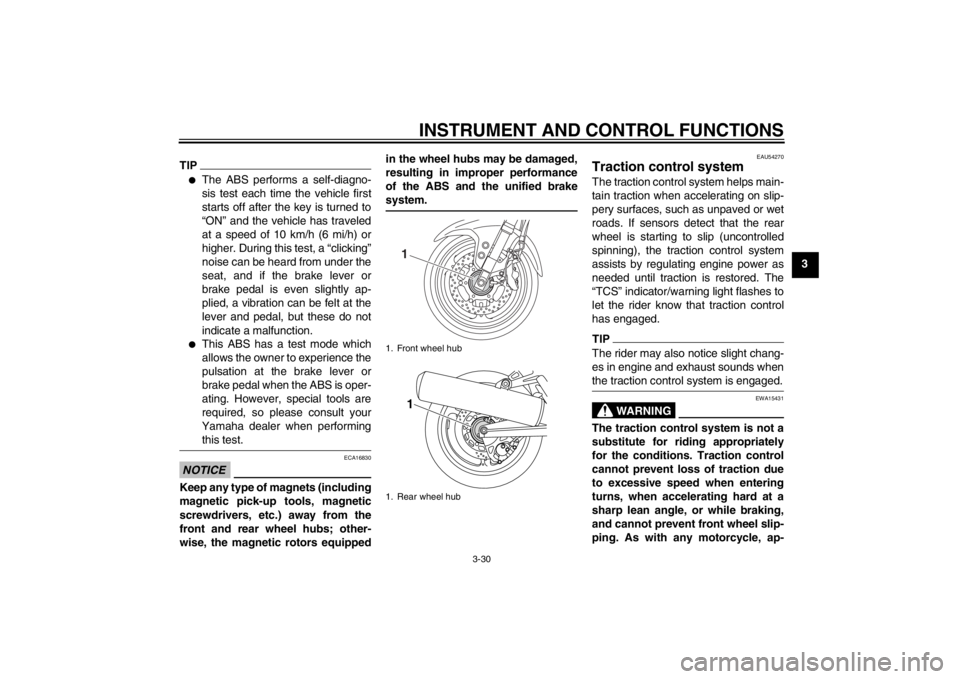
INSTRUMENT AND CONTROL FUNCTIONS
3-30
3
TIP●
The ABS performs a self-diagno-
sis test each time the vehicle first
starts off after the key is turned to
“ON” and the vehicle has traveled
at a speed of 10 km/h (6 mi/h) or
higher. During this test, a “clicking”
noise can be heard from under the
seat, and if the brake lever or
brake pedal is even slightly ap-
plied, a vibration can be felt at the
lever and pedal, but these do not
indicate a malfunction.
●
This ABS has a test mode which
allows the owner to experience the
pulsation at the brake lever or
brake pedal when the ABS is oper-
ating. However, special tools are
required, so please consult your
Yamaha dealer when performing this test.
NOTICE
ECA16830
Keep any type of magnets (including
magnetic pick-up tools, magnetic
screwdrivers, etc.) away from the
front and rear wheel hubs; other-
wise, the magnetic rotors equipped in the wheel hubs may be damaged,
resulting in improper performance
of the ABS and the unified brake
system.
EAU54270
Traction control system The traction control system helps main-
tain traction when accelerating on slip-
pery surfaces, such as unpaved or wet
roads. If sensors detect that the rear
wheel is starting to slip (uncontrolled
spinning), the traction control system
assists by regulating engine power as
needed until traction is restored. The
“TCS” indicator/warning light flashes to
let the rider know that traction control
has engaged.TIPThe rider may also notice slight chang-
es in engine and exhaust sounds when
the traction control system is engaged.
WARNING
EWA15431
The traction control system is not a
substitute for riding appropriately
for the conditions. Traction control
cannot prevent loss of traction due
to excessive speed when entering
turns, when accelerating hard at a
sharp lean angle, or while braking,
and cannot prevent front wheel slip-
ping. As with any motorcycle, ap-
1. Front wheel hub
1. Rear wheel hub
11
U1MDE0E0.book Page 30 Friday, February 15, 2013 1:26 PM
Page 46 of 122
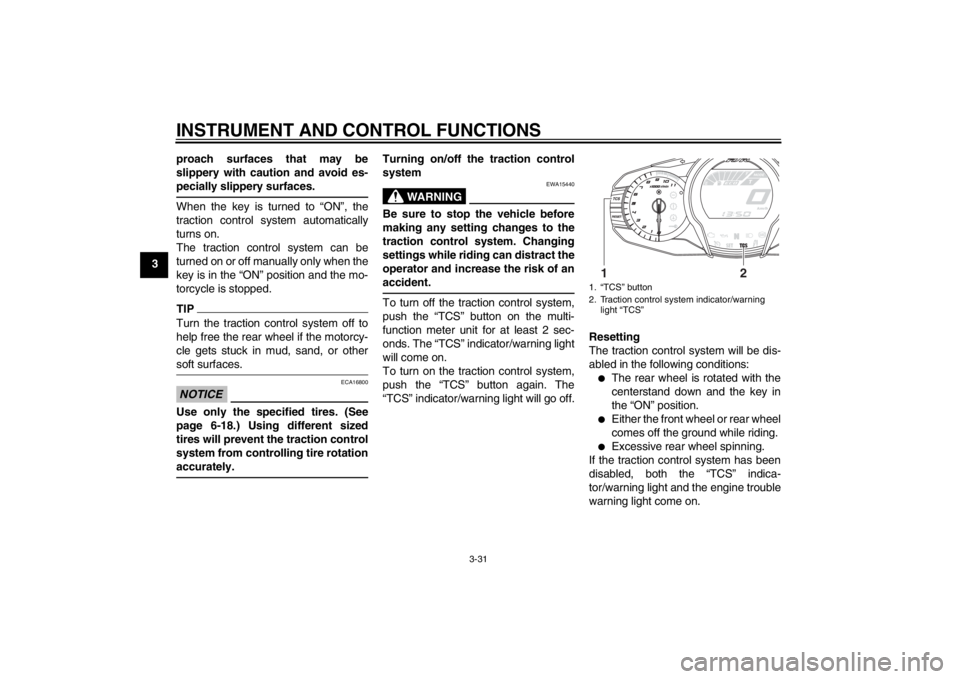
INSTRUMENT AND CONTROL FUNCTIONS
3-31
3proach surfaces that may be
slippery with caution and avoid es-
pecially slippery surfaces.
When the key is turned to “ON”, the
traction control system automatically
turns on.
The traction control system can be
turned on or off manually only when the
key is in the “ON” position and the mo-
torcycle is stopped.TIPTurn the traction control system off to
help free the rear wheel if the motorcy-
cle gets stuck in mud, sand, or other
soft surfaces.NOTICE
ECA16800
Use only the specified tires. (See
page 6-18.) Using different sized
tires will prevent the traction control
system from controlling tire rotation
accurately.
Turning on/off the traction control
system
WARNING
EWA15440
Be sure to stop the vehicle before
making any setting changes to the
traction control system. Changing
settings while riding can distract the
operator and increase the risk of an
accident.To turn off the traction control system,
push the “TCS” button on the multi-
function meter unit for at least 2 sec-
onds. The “TCS” indicator/warning light
will come on.
To turn on the traction control system,
push the “TCS” button again. The
“TCS” indicator/warning light will go off.
Resetting
The traction control system will be dis-
abled in the following conditions:
●
The rear wheel is rotated with the
centerstand down and the key in
the “ON” position.
●
Either the front wheel or rear wheel
comes off the ground while riding.
●
Excessive rear wheel spinning.
If the traction control system has been
disabled, both the “TCS” indica-
tor/warning light and the engine trouble
warning light come on.
1. “TCS” button
2. Traction control system indicator/warning light “TCS”
1
2
U1MDE0E0.book Page 31 Friday, February 15, 2013 1:26 PM
Page 47 of 122
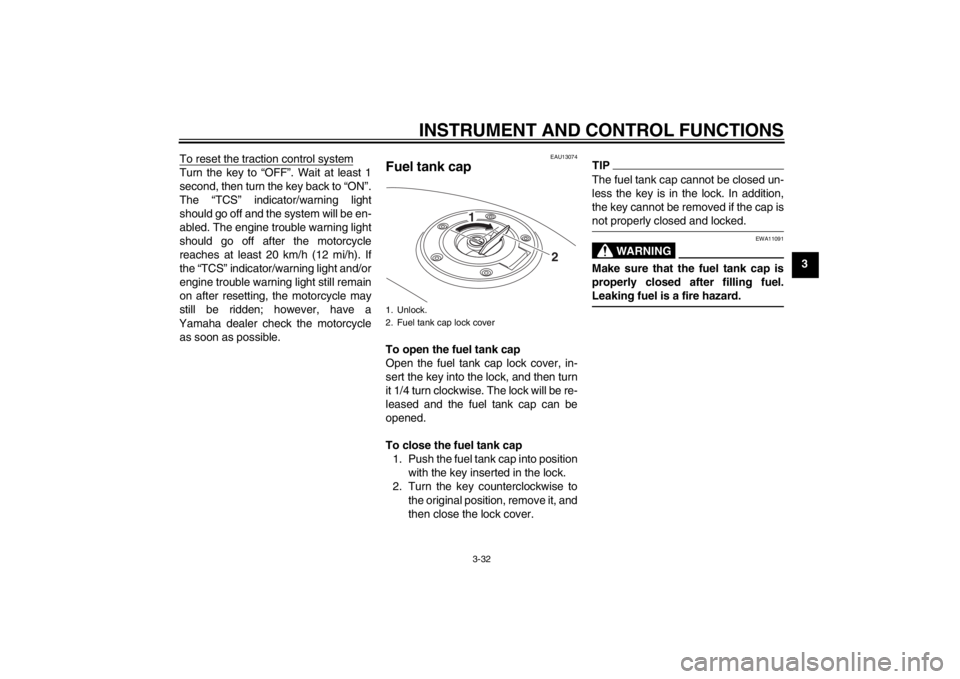
INSTRUMENT AND CONTROL FUNCTIONS
3-32
3
To reset the traction control system
Turn the key to “OFF”. Wait at least 1
second, then turn the key back to “ON”.
The “TCS” indicator/warning light
should go off and the system will be en-
abled. The engine trouble warning light
should go off after the motorcycle
reaches at least 20 km/h (12 mi/h). If
the “TCS” indicator/warning light and/or
engine trouble warning light still remain
on after resetting, the motorcycle may
still be ridden; however, have a
Yamaha dealer check the motorcycle as soon as possible.
EAU13074
Fuel tank cap To open the fuel tank cap
Open the fuel tank cap lock cover, in-
sert the key into the lock, and then turn
it 1/4 turn clockwise. The lock will be re-
leased and the fuel tank cap can be
opened.
To close the fuel tank cap 1. Push the fuel tank cap into position with the key inserted in the lock.
2. Turn the key counterclockwise to the original position, remove it, and
then close the lock cover.
TIPThe fuel tank cap cannot be closed un-
less the key is in the lock. In addition,
the key cannot be removed if the cap is
not properly closed and locked.
WARNING
EWA11091
Make sure that the fuel tank cap is
properly closed after filling fuel.
Leaking fuel is a fire hazard.
1. Unlock.
2. Fuel tank cap lock cover
2
1
U1MDE0E0.book Page 32 Friday, February 15, 2013 1:26 PM
Page 48 of 122
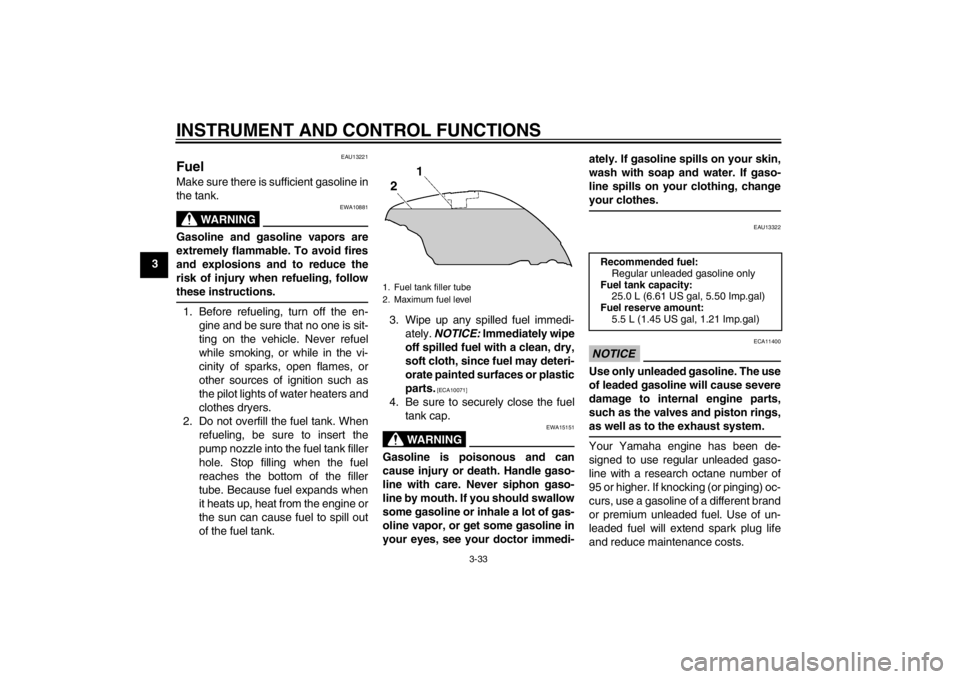
INSTRUMENT AND CONTROL FUNCTIONS
3-33
3
EAU13221
Fuel Make sure there is sufficient gasoline in
the tank.
WARNING
EWA10881
Gasoline and gasoline vapors are
extremely flammable. To avoid fires
and explosions and to reduce the
risk of injury when refueling, follow
these instructions.1. Before refueling, turn off the en-gine and be sure that no one is sit-
ting on the vehicle. Never refuel
while smoking, or while in the vi-
cinity of sparks, open flames, or
other sources of ignition such as
the pilot lights of water heaters and
clothes dryers.
2. Do not overfill the fuel tank. When refueling, be sure to insert the
pump nozzle into the fuel tank filler
hole. Stop filling when the fuel
reaches the bottom of the filler
tube. Because fuel expands when
it heats up, heat from the engine or
the sun can cause fuel to spill out
of the fuel tank. 3. Wipe up any spilled fuel immedi-
ately. NOTICE: Immediately wipe
off spilled fuel with a clean, dry,
soft cloth, since fuel may deteri-
orate painted surfaces or plastic
parts.
[ECA10071]
4. Be sure to securely close the fuel tank cap.
WARNING
EWA15151
Gasoline is poisonous and can
cause injury or death. Handle gaso-
line with care. Never siphon gaso-
line by mouth. If you should swallow
some gasoline or inhale a lot of gas-
oline vapor, or get some gasoline in
your eyes, see your doctor immedi- ately. If gasoline spills on your skin,
wash with soap and water. If gaso-
line spills on your clothing, change
your clothes.
EAU13322
NOTICE
ECA11400
Use only unleaded gasoline. The use
of leaded gasoline will cause severe
damage to internal engine parts,
such as the valves and piston rings,
as well as to the exhaust system.Your Yamaha engine has been de-
signed to use regular unleaded gaso-
line with a research octane number of
95 or higher. If knocking (or pinging) oc-
curs, use a gasoline of a different brand
or premium unleaded fuel. Use of un-
leaded fuel will extend spark plug life
and reduce maintenance costs.
1. Fuel tank filler tube
2. Maximum fuel level
Recommended fuel:
Regular unleaded gasoline only
Fuel tank capacity: 25.0 L (6.61 US gal, 5.50 Imp.gal)
Fuel reserve amount: 5.5 L (1.45 US gal, 1.21 Imp.gal)
U1MDE0E0.book Page 33 Friday, February 15, 2013 1:26 PM
Page 49 of 122
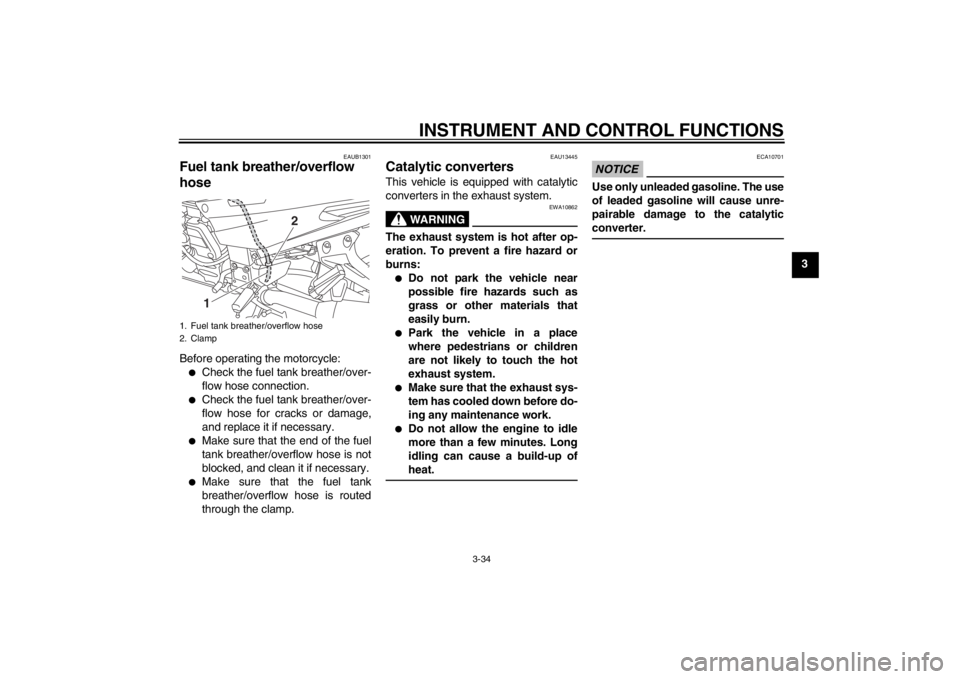
INSTRUMENT AND CONTROL FUNCTIONS
3-34
3
EAUB1301
Fuel tank breather/overflow
hose Before operating the motorcycle:●
Check the fuel tank breather/over-
flow hose connection.
●
Check the fuel tank breather/over-
flow hose for cracks or damage,
and replace it if necessary.
●
Make sure that the end of the fuel
tank breather/overflow hose is not
blocked, and clean it if necessary.
●
Make sure that the fuel tank
breather/overflow hose is routed
through the clamp.
EAU13445
Catalytic converters This vehicle is equipped with catalytic
converters in the exhaust system.
WARNING
EWA10862
The exhaust system is hot after op-
eration. To prevent a fire hazard or
burns:●
Do not park the vehicle near
possible fire hazards such as
grass or other materials that
easily burn.
●
Park the vehicle in a place
where pedestrians or children
are not likely to touch the hot
exhaust system.
●
Make sure that the exhaust sys-
tem has cooled down before do-
ing any maintenance work.
●
Do not allow the engine to idle
more than a few minutes. Long
idling can cause a build-up of
heat.
NOTICE
ECA10701
Use only unleaded gasoline. The use
of leaded gasoline will cause unre-
pairable damage to the catalytic
converter.
1. Fuel tank breather/overflow hose
2. Clamp
2
1
U1MDE0E0.book Page 34 Friday, February 15, 2013 1:26 PM
Page 50 of 122
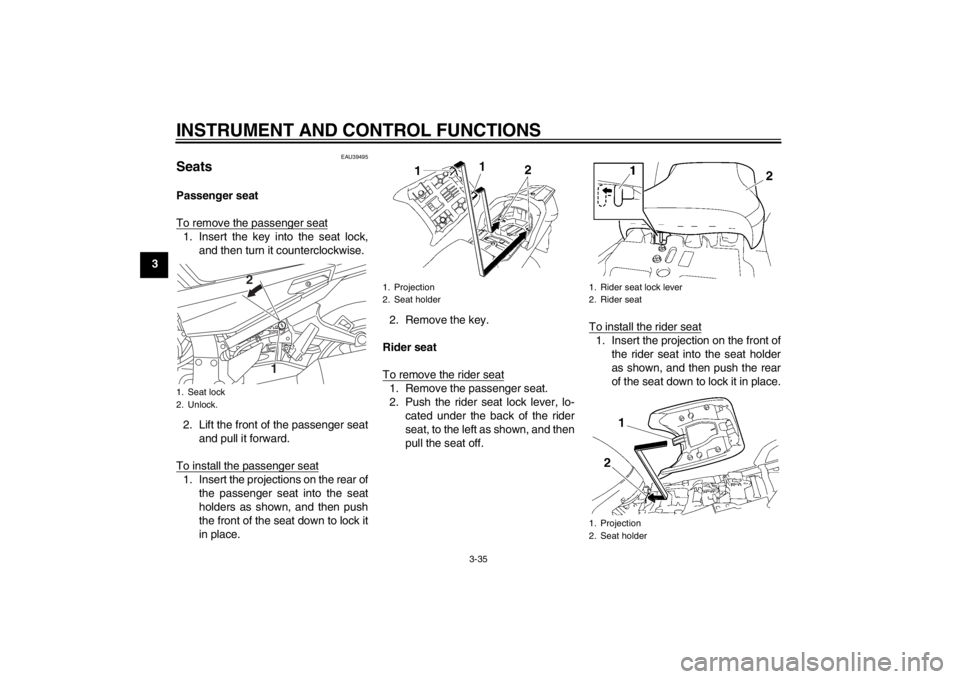
INSTRUMENT AND CONTROL FUNCTIONS
3-35
3
EAU39495
Seats Passenger seat
To remove the passenger seat1. Insert the key into the seat lock,and then turn it counterclockwise.
2. Lift the front of the passenger seat and pull it forward.
To install the passenger seat1. Insert the projections on the rear of the passenger seat into the seat
holders as shown, and then push
the front of the seat down to lock it
in place. 2. Remove the key.
Rider seat
To remove the rider seat
1. Remove the passenger seat.
2. Push the rider seat lock lever, lo- cated under the back of the rider
seat, to the left as shown, and then
pull the seat off. To install the rider seat
1. Insert the projection on the front of
the rider seat into the seat holder
as shown, and then push the rear
of the seat down to lock it in place.
1. Seat lock
2. Unlock.
1
2
1. Projection
2. Seat holder
1. Rider seat lock lever
2. Rider seat
1. Projection
2. Seat holder
U1MDE0E0.book Page 35 Friday, February 15, 2013 1:26 PM